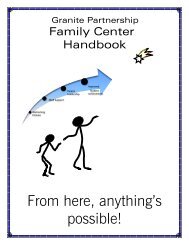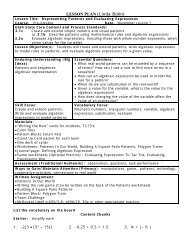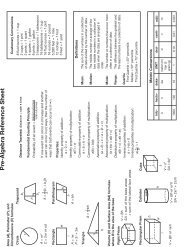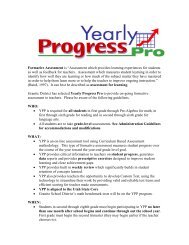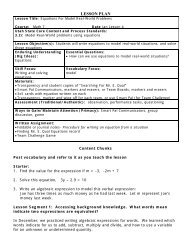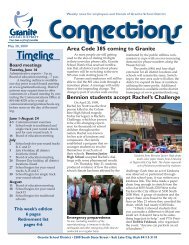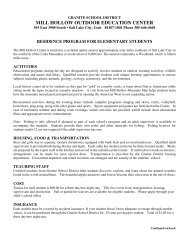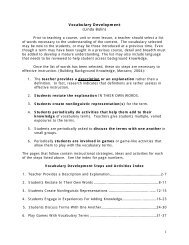Utah's Least Restrictive Behavioral Interventions Guidelines
Utah's Least Restrictive Behavioral Interventions Guidelines
Utah's Least Restrictive Behavioral Interventions Guidelines
Create successful ePaper yourself
Turn your PDF publications into a flip-book with our unique Google optimized e-Paper software.
ules/expectations is proactive and often prevents behavioral problems from occurring, which saves instructional<br />
time. One of the greatest benefits is an increase in instructional time.<br />
Points to Consider When Teaching <strong>Behavioral</strong> Expectations/Rules<br />
Keep a record of plans for institutional memory (your handbook or syllabus) and future planning.<br />
Keep notes during the teaching process for things to adjust when re-teaching.<br />
Be sure to adapt lesson presentation for developmental levels (i.e., student age).<br />
Plan for re-teaching opportunities (i.e., following extended breaks from school).<br />
Plan for how following the expectation/rule will be positively acknowledged.<br />
Plan for how failure to follow the expectation/rule will be corrected and re-taught.<br />
Best practice for teaching expectations/rules is to use an explicit instructional process:<br />
Suggested Instructional Sequence for Teaching <strong>Behavioral</strong> Expectations<br />
Define expectation/rule.<br />
Provide rationale for expectation/rule.<br />
Teach critical discrimination of expectation/rule (model examples and non-examples).<br />
Practice the behavior (in setting where behavior is required, if possible).<br />
Discuss what will happen when expectations/rules are followed and what will happen if behavioral errors occur.<br />
In addition to establishing and teaching behavioral expectations/rules, effective teachers systematically teach basic<br />
classroom routines/procedures where behavioral infractions tend to occur.<br />
Suggested Routines/Procedures to Consider<br />
Transitions (i.e., moving from one activity to another, in or out of classroom).<br />
Getting assistance.<br />
Working independently.<br />
Working in groups.<br />
Lining up.<br />
Handing in homework and assignments.<br />
Sharpening pencils and preparing materials.<br />
Hall passes (i.e., bathroom breaks, phone calls).<br />
Procedures specific to classroom equipment (i.e., computers).<br />
Classroom schedule.<br />
Reinforce Expectations/Rules<br />
Positive adult attention to appropriate student behaviors is the most powerful way to encourage, increase<br />
and maintain positive behavior in the school setting. Expectations/rules that are well defined and explicitly taught<br />
are an essential component of proactive and preventative school-wide and classroom management. However,<br />
acknowledging and positively reinforcing students for demonstrating the desired behavioral skill increases the<br />
7




